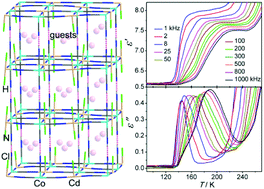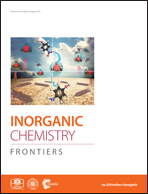Cation-templated cyanometallate-based supramolecular rectangular cage compounds showing dielectric transitions†
Abstract
Four Cd(II)–Co(III) cyanometallate frameworks have been assembled with the general formula of A2{H(CdCl2)[Co(CN)6]} (A = monovalent organic cation). The cation A is imidazolium (Him) in 1, pyrazolium (Hpa) in 2, guanidinium (Hgu) in 3 and protonated thiourea (Htu) in 4. The common structural feature of the four compounds is the supramolecular rectangular cage which is formed via CN⋯H⋯NC hydrogen bonds between neighboring two-dimensional Cd(II)–Co(III) cyanometallate grids. Variable-temperature X-ray diffraction, differential scanning calorimetry and dielectric constant measurements show that 1, 3, and 4, among the four compounds, exhibit dielectric transitions. The origin of the dielectric responses is attributed to relatively small displacements or thermal vibrations rather than rotational motions of the polar A guests in the rectangular cage. Furthermore, 1 and 4 show unambiguous dielectric relaxations with wide diffusion regions between 120 and 220 K and 1 and 1000 kHz.



 Please wait while we load your content...
Please wait while we load your content...